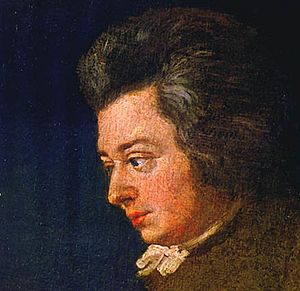Requiem (Mozart) facts for kids
Quick facts for kids Requiem |
|
|---|---|
| by Wolfgang Amadeus Mozart | |

The composer in 1782
|
|
| Key | D minor |
| Catalogue | K. 626 |
| Text | Requiem |
| Language | Latin |
| Composed | 1791 |
| Scoring |
|
The Requiem Mass in D minor (K. 626) is a very famous piece of music. It was written by the well-known composer Wolfgang Amadeus Mozart in 1791. A Requiem is a special church service, or "mass," held to remember people who have passed away.
This Requiem was the last piece of music Mozart ever worked on. He was actually writing it while he himself was very ill and dying. It seems he couldn't finish it before he died. Another musician named Franz Xaver Süßmayr helped complete the work after Mozart's death.
People still wonder how much of the music was truly Mozart's. They also discuss how much Süssmayr had to add. There are many stories and ideas about how the Requiem was put together. It's a topic that musicians and historians still talk about a lot today.
Contents
The Mystery of the Requiem
Mozart received a secret request to write this Requiem. A mysterious messenger asked him to compose a Mass for the dead. Mozart was already sick when he started writing it. He felt like he was writing it for himself.
Who Finished the Music?
After Mozart died, his wife, Constanze, needed the Requiem to be finished. This was because she had already been paid for it. She asked several composers to complete the work.
Süssmayr's Role
Finally, Franz Xaver Süßmayr, one of Mozart's students, finished the Requiem. He added parts that Mozart had not completed. This included some of the music for the "Lacrimosa" section. He also wrote the "Sanctus," "Benedictus," and "Agnus Dei" sections.
What Was Mozart's Part?
We know that Mozart wrote the first part, called the "Introitus." He also wrote most of the "Kyrie," "Dies Irae," and "Confutatis." He left detailed notes and sketches for Süssmayr to follow.
Why is it Famous?
The Requiem is famous for many reasons. It's a powerful and emotional piece of music. It shows Mozart's incredible talent, even in his final days.
Its Emotional Power
The music often sounds sad and serious, but also hopeful. It uses a large choir and orchestra to create a grand sound. Many people find it very moving to listen to.
A Lasting Legacy
Even though it was unfinished, the Requiem is one of Mozart's most important works. It has been performed countless times around the world. It reminds us of Mozart's genius and the mystery surrounding his death.
Images for kids
-
The beginning of the Dies irae in the autograph manuscript, with Eybler's orchestration. In the upper right, Nissen has left a note: "All which is not enclosed by the quill is of Mozart's hand up to page 32." The first violin, choir and figured bass are entirely Mozart's.
-
1857 lithograph by Franz Schramm, titled Ein Moment aus den letzten Tagen Mozarts ("Moment from the Last Days of Mozart"). Mozart, with the score of the Requiem on his lap, gives Süssmayr last-minute instructions. Constanze is to the side and the messenger is leaving through the main door.
-
Michael Haydn (younger brother of Joseph Haydn), whose own Requiem influenced Mozart
See also







